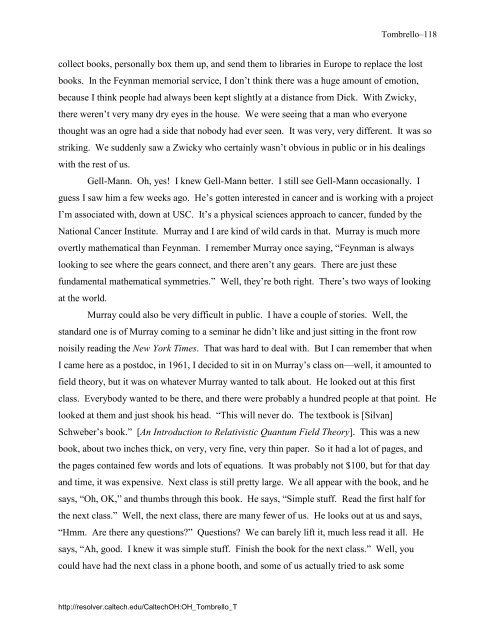Interview with Thomas A. Tombrello - Caltech Oral Histories
Interview with Thomas A. Tombrello - Caltech Oral Histories
Interview with Thomas A. Tombrello - Caltech Oral Histories
Create successful ePaper yourself
Turn your PDF publications into a flip-book with our unique Google optimized e-Paper software.
<strong>Tombrello</strong>–118<br />
collect books, personally box them up, and send them to libraries in Europe to replace the lost<br />
books. In the Feynman memorial service, I don’t think there was a huge amount of emotion,<br />
because I think people had always been kept slightly at a distance from Dick. With Zwicky,<br />
there weren’t very many dry eyes in the house. We were seeing that a man who everyone<br />
thought was an ogre had a side that nobody had ever seen. It was very, very different. It was so<br />
striking. We suddenly saw a Zwicky who certainly wasn’t obvious in public or in his dealings<br />
<strong>with</strong> the rest of us.<br />
Gell-Mann. Oh, yes! I knew Gell-Mann better. I still see Gell-Mann occasionally. I<br />
guess I saw him a few weeks ago. He’s gotten interested in cancer and is working <strong>with</strong> a project<br />
I’m associated <strong>with</strong>, down at USC. It’s a physical sciences approach to cancer, funded by the<br />
National Cancer Institute. Murray and I are kind of wild cards in that. Murray is much more<br />
overtly mathematical than Feynman. I remember Murray once saying, “Feynman is always<br />
looking to see where the gears connect, and there aren’t any gears. There are just these<br />
fundamental mathematical symmetries.” Well, they’re both right. There’s two ways of looking<br />
at the world.<br />
Murray could also be very difficult in public. I have a couple of stories. Well, the<br />
standard one is of Murray coming to a seminar he didn’t like and just sitting in the front row<br />
noisily reading the New York Times. That was hard to deal <strong>with</strong>. But I can remember that when<br />
I came here as a postdoc, in 1961, I decided to sit in on Murray’s class on—well, it amounted to<br />
field theory, but it was on whatever Murray wanted to talk about. He looked out at this first<br />
class. Everybody wanted to be there, and there were probably a hundred people at that point. He<br />
looked at them and just shook his head. “This will never do. The textbook is [Silvan]<br />
Schweber’s book.” [An Introduction to Relativistic Quantum Field Theory]. This was a new<br />
book, about two inches thick, on very, very fine, very thin paper. So it had a lot of pages, and<br />
the pages contained few words and lots of equations. It was probably not $100, but for that day<br />
and time, it was expensive. Next class is still pretty large. We all appear <strong>with</strong> the book, and he<br />
says, “Oh, OK,” and thumbs through this book. He says, “Simple stuff. Read the first half for<br />
the next class.” Well, the next class, there are many fewer of us. He looks out at us and says,<br />
“Hmm. Are there any questions?” Questions? We can barely lift it, much less read it all. He<br />
says, “Ah, good. I knew it was simple stuff. Finish the book for the next class.” Well, you<br />
could have had the next class in a phone booth, and some of us actually tried to ask some<br />
http://resolver.caltech.edu/<strong>Caltech</strong>OH:OH_<strong>Tombrello</strong>_T

















